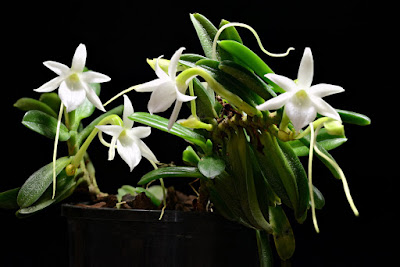Angraecum equitans is native to Madagascar. It grows in lichen forest on the slopes of the Tsaratanana Massif, at an altitude of around 2000 meters. It grows epiphytically on the outer branches of moss- and lichen-covered trees, where it often receives almost full sun
Angraecum equitans also called as The Riding one above the other Angraecum, Humblotiangraecum equitans, is a species of the genus Angraecum. This species was described by Friedrich Richard Rudolf Schlechter in 1916.
IDENTIFY ANGRAECUM EQUITANS ORCHID PLANT
Angraecum equitans is native to Madagascar. It grows in lichen forest on the slopes of the Tsaratanana Massif, at an altitude of around 2000 meters. It grows epiphytically on the outer branches of moss- and lichen-covered trees, where it often receives almost full sun. However, the effect of such bright light is tempered by the humid conditions, and the plant experiences early morning dew and mist every month of the year. For about 3 months, during the dry season (the Madagascan winter), Angraecum equitans is chilled by nighttime temperatures often down to 10°C or lower.
It is a miniature sized, cool to cold growing epiphyte that has a stem which branches freely in mature plants and is most often upright and not pendant, and is densely, equitant leafed with fleshy, dark green, curved and somewhat glossy, and obtusely bilobed leaves.
The Riding one above the other Angraecum blooms in the late spring on a 7.5 cm long, 1 to 3 flowered inflorescence enveloped completely by folded bracts. The beautiful white flowers are quite large for the size of the plant and last for 3-4 weeks.
ANGRAECUM EQUITANS ORCHID PLANT CARE AND CULTURE
Cultural information should only be used as a guide, and should be to be adapted to suit you. Your physical location; where you grow your plants, how much time you have to devote to their care, and many other factors, will need to be taken into account. Only then can you decide on the cultural methods that best suit you and your plants.
Light:
Angraecum equitans needs a light level of 8000-15000 lux. Light should be filtered or diffused, and plants should not be exposed to direct midday sun. Strong air movement should be provided at all times. These plants have much lower light needs than many other angraecums and bloom well with winter light levels as low as 5000-8000 lux.
Temperature:
Summer days temperature at average 19-21°C, and nights average 12°C, with a diurnal range of 7-8°C. Intermediate conditions are recommended, but faced with a choice, it could probably tolerate a cool house better than a warm one. In any event, these plants should thrive if grown in the cool, moist airflow from an evaporative cooler.
Humidity:
The Riding one above the other Angraecum need the humidity of 80-85% for most of the summer into early autumn. Averages then drop to near 65% in winter and early spring.
Substrate, growing media and repotting:
Angraecum equitans may be grown in shallow, well-drained containers or mounted on tree-fern slabs. Mounted plants need high humidity, however, and during hot, dry weather they may need several waterings a day.
If it is difficult to keep mounted plants moist enough, they may be grown in a shallow pot or basket filled with a very open, fast-draining medium that has excellent drainage, is well aerated, and allows the medium to dry fairly rapidly after watering. Growers generally use fir bark or shredded tree-fern fiber and add varying amounts of chunky perlite and/or chopped sphagnum moss to keep the medium open and retain some moisture. Including charcoal in the mix also holds the medium open and prevents souring in the pot. However, mounted plants are likely to suffer dehydration and that these small plants probably are best grown in a 6.4-9.0 cm pot filled with fairly fine fir bark. They stated that overwatering can be deadly, however.
Plants should be repotted immediately if the medium starts to break down or whenever the plant outgrows its container. Repotting should be done just as new roots start to grow. This enables the plant to become reestablished in the shortest possible time.
Watering:
Rainfall in the region is heavy in summer and early autumn, but averages then fall quickly into a dry season that extends for 6-7 months from mid-autumn through the following spring. More moisture probably is available in the high-elevation habitat from fog and mist than is indicated by the rainfall averages from the low-elevation weather station, however. Cultivated plants should be watered heavily and be allowed to become somewhat dry between waterings while actively growing. Water should be reduced after growth is completed, however.
Fertilizer:
1/4-1/2 recommended strength, applied weekly when plants are actively growing. You can use a balanced fertilizer throughout the year; but also can use a high-nitrogen fertilizer from spring to midsummer, then switch to one high in phosphates in late summer and autumn.
Rest period:
Winter days temperature at average 17-18°C, and nights average 9-10°C, with a diurnal range of 8°C. Water should be reduced after growth is completed and the Angraecum equitans kept somewhat on the dry side until new growth starts in spring. Somewhat regular early-morning mistings between occasional light waterings should provide sufficient moisture in most growing areas. Fertilizer should be eliminated until heavier watering is resumed in spring.















COMMENTS